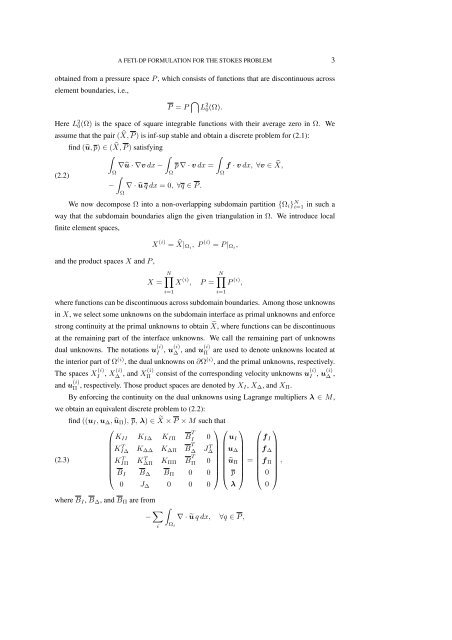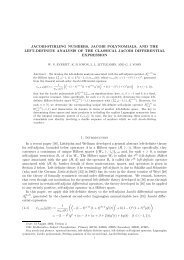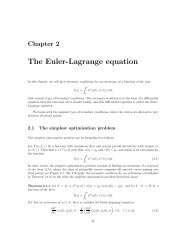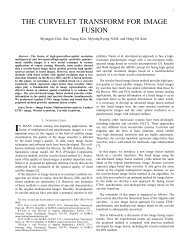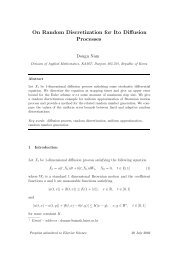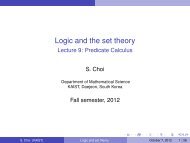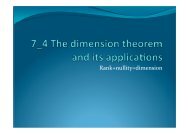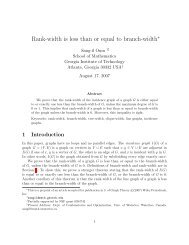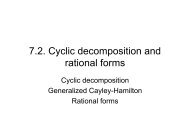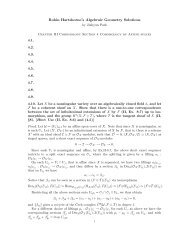On the selection of primal unknowns for a FETI-DP formulation of the ...
On the selection of primal unknowns for a FETI-DP formulation of the ...
On the selection of primal unknowns for a FETI-DP formulation of the ...
- No tags were found...
You also want an ePaper? Increase the reach of your titles
YUMPU automatically turns print PDFs into web optimized ePapers that Google loves.
A <strong>FETI</strong>-<strong>DP</strong> FORMULATION FOR THE STOKES PROBLEM 3obtained from a pressure space P , which consists <strong>of</strong> functions that are discontinuous acrosselement boundaries, i.e.,P = P ⋂ L 2 0(Ω).Here L 2 0(Ω) is <strong>the</strong> space <strong>of</strong> square integrable functions with <strong>the</strong>ir average zero in Ω. Weassume that <strong>the</strong> pair ( ̂X, P ) is inf-sup stable and obtain a discrete problem <strong>for</strong> (2.1):find (û, p) ∈ ( ̂X, P ) satisfying∫∫∫∇û · ∇v dx − p ∇ · v dx =(2.2)Ω∫Ω− ∇ · û q dx = 0, ∀q ∈ P .ΩΩf · v dx, ∀v ∈ ̂X,We now decompose Ω into a non-overlapping subdomain partition {Ω i } N i=1 in such away that <strong>the</strong> subdomain boundaries align <strong>the</strong> given triangulation in Ω. We introduce localfinite element spaces,and <strong>the</strong> product spaces X and P ,X (i) = ̂X| Ωi , P (i) = P | Ωi ,N∏N∏X = X (i) , P = P (i) ,i=1where functions can be discontinuous across subdomain boundaries. Among those <strong>unknowns</strong>in X, we select some <strong>unknowns</strong> on <strong>the</strong> subdomain interface as <strong>primal</strong> <strong>unknowns</strong> and en<strong>for</strong>cestrong continuity at <strong>the</strong> <strong>primal</strong> <strong>unknowns</strong> to obtain ˜X, where functions can be discontinuousat <strong>the</strong> remaining part <strong>of</strong> <strong>the</strong> interface <strong>unknowns</strong>. We call <strong>the</strong> remaining part <strong>of</strong> <strong>unknowns</strong>dual <strong>unknowns</strong>. The notations u (i)I, u(i) ∆, and u(i)Πare used to denote <strong>unknowns</strong> located at<strong>the</strong> interior part <strong>of</strong> Ω (i) , <strong>the</strong> dual <strong>unknowns</strong> on ∂Ω (i) , and <strong>the</strong> <strong>primal</strong> <strong>unknowns</strong>, respectively.The spaces X (i)I, X(i) ∆, and X(i)Πi=1consist <strong>of</strong> <strong>the</strong> corresponding velocity <strong>unknowns</strong> u(i)I, u(i) ∆ ,and u (i)Π , respectively. Those product spaces are denoted by X I, X ∆ , and X Π .By en<strong>for</strong>cing <strong>the</strong> continuity on <strong>the</strong> dual <strong>unknowns</strong> using Lagrange multipliers λ ∈ M,we obtain an equivalent discrete problem to (2.2):find ((u I , u ∆ , û Π ), p, λ) ∈ ˜X × P × M such that⎛⎞ ⎛ ⎞ ⎛ ⎞K II K I∆ K IΠ B T I 0 u I f IKI∆ T K ∆∆ K ∆Π B T ∆ J∆T u ∆f ∆(2.3)K IΠ T KT ∆Π K ΠΠ B T Π 0û Π=f Π,⎜⎝ B I B ∆ B Π 0 0⎟ ⎜⎠ ⎝ p ⎟ ⎜⎠ ⎝ 0 ⎟⎠0 J ∆ 0 0 0 λ 0where B I , B ∆ , and B Π are from− ∑ i∫Ω i∇ · ũ q dx, ∀q ∈ P ,


